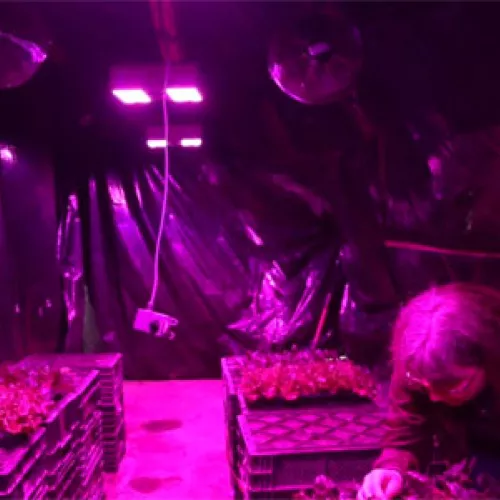Two groups, Outsourced Innovations, a lighting consulting firm, and Tangletown Gardens, a greenhouse nursery and garden business, recently completed an 12-month study of greenhouse-specific LED lighting technology. This study was funded through a Minnesota Department of Commerce Conservation Applied Research and Development (CARD) grant.
The project investigated whether greenhouse-specific LEDs were market ready to include as an energy saving technology in the the Conservation Improvement Program. Outsourced Innovations measured and validated the project and communicated outcomes to the Minnesota Department of Commerce, Tangletown Gardens, and related stakeholders. Research findings will help commercial greenhouse growers and utilities understand the variation in LED performance, compare the advantages of LEDs, and benchmark against conventional lighting used in commercial greenhouse crop production.
The Findings:
- This research found that greenhouse-specific LED lamps significantly reduced energy consumption and were exceptionally cost-effective when compared to high pressure sodium lamps, the conventional greenhouse lighting technology. The PAR (photosynthetically active radiation) range-specific LEDs could be programmed to red, blue or white, which gave greenhouses more options for energy savings and some growth advantages.
- The research validated that a 43% energy savings would be realized when controlled crop environments were lit with LED lamps compared to conventional high pressure sodium (HPS) lamps. The research also demonstrated LED lamp reliability over 6,000 hours of use. Measured light depreciation, which occurs in all lighting technology, occurred at a much slower rate in LEDs than HPS lamps. Additionally, the HPS bulbs and an electronic ballast failed twice during the course of the study.
- Although at a higher initial cost, LED lamps provided a net present savings of $5,745 in energy and maintenance costs over the 5-year life of the LED fixtures compared to HPS fixtures. The energy savings payback from LEDs was estimated at an impressive 2.2 years.
- The study also examined light impacts on plant growth resulting from different light intensities and wavelengths of LEDs versus HPS in real-world commercial growing environments. This aspect of the study served to validate unsubstantiated claims made by LED manufacturers about growth. Through a side-by-side control and test environment, the project team closely examined how plants responded to the white, blue and red light qualities from the different LED and HPS fixtures.
For more information, check out the webinar recording and cool video below!


